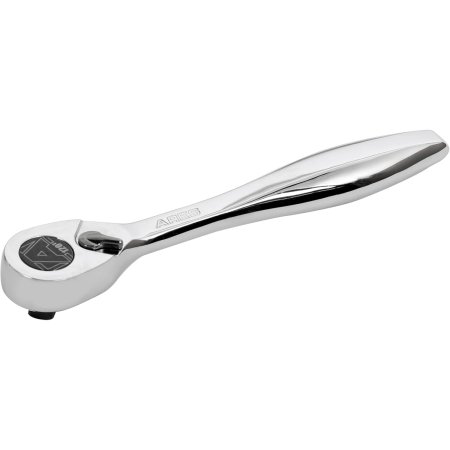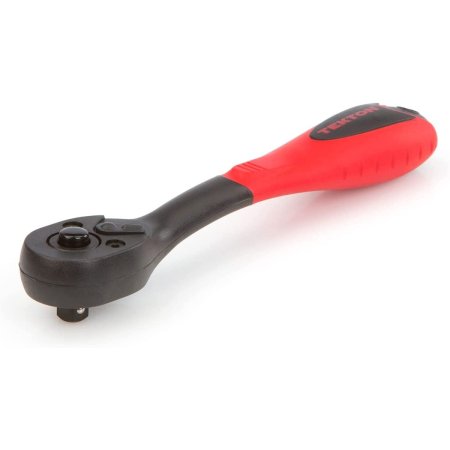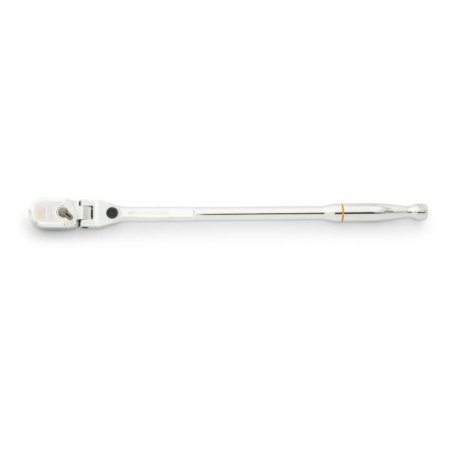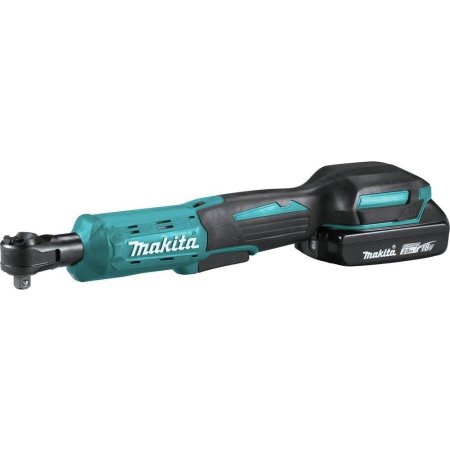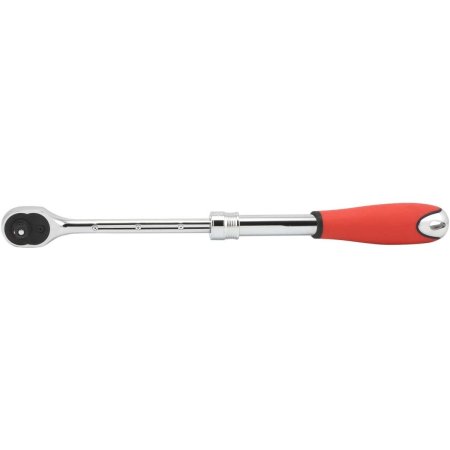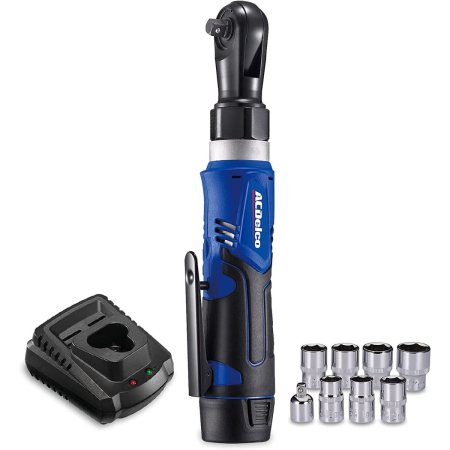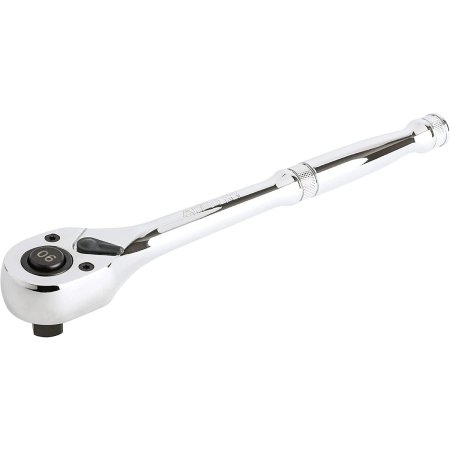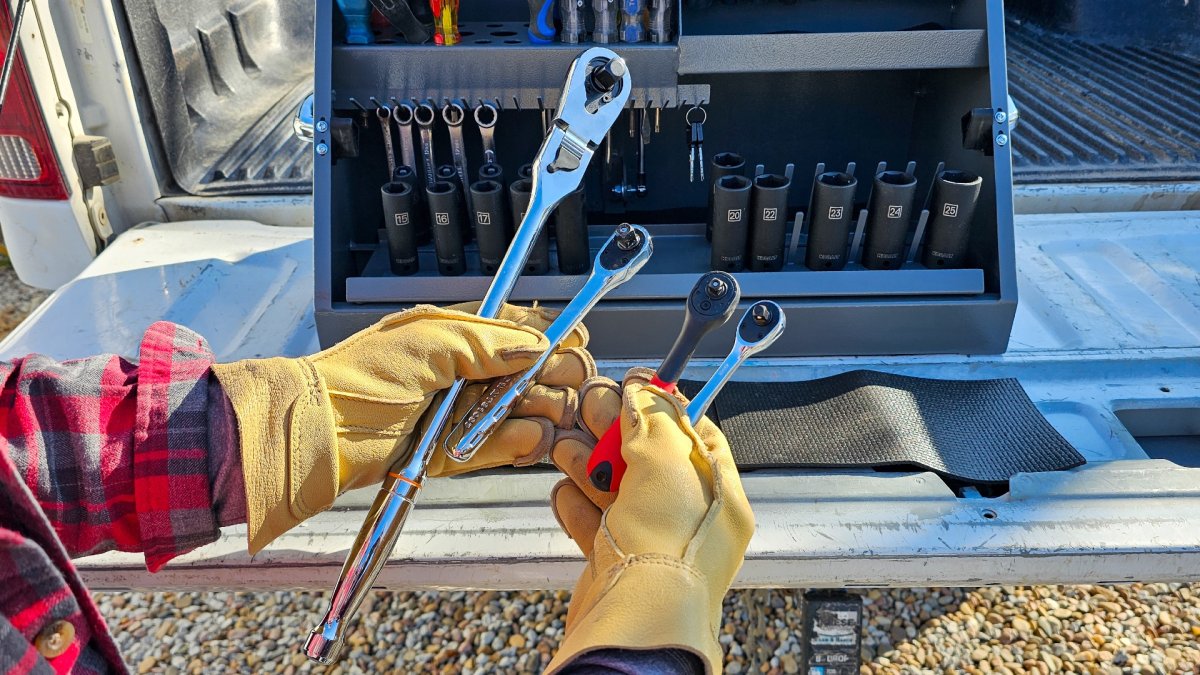
We may earn revenue from the products available on this page and participate in affiliate programs. Learn More ›
Whether you’re tackling auto repairs or tightening fasteners on DIY projects, a good ratchet can save time. A ratchet is a socket wrench designed to tighten or loosen fasteners quickly while bypassing the need to manually reposition the tool after each turn. After researching over 30 best-selling ratchets on the market, we selected nine for our lineup. Of those nine, we tested the top five on vehicle bolts and other fasteners in our workshop to see if they lived up to their manufacturer’s claims.
While all the ratchets performed well, we found a clear favorite—the DeWalt ⅜-Inch Quick-Release Ratchet. We especially appreciated its 5-degree arc swing, a quick-release button for easy socket changes, and an anti-slip handle for control.
Basic as these hand tools are, they’re not one-size-fits-all, so it’s important to find a ratchet that best suits the task at hand. There’s a big difference between a high-end ratchet and a low-quality one. In this guide, we’ll explain what to look for in a ratchet and share how the following models earned a spot on this lineup of the best ratchets.
- BEST OVERALL: DeWalt ⅜-Inch Quick-Release Ratchet
↓ Jump to Review - BEST BANG FOR THE BUCK: Ares ¼-inch Reversible Ratchet
↓ Jump to Review - BEST ERGONOMIC: Tekton ¼-Inch Composite Quick-Release Ratchet
↓ Jump to Review - BEST FLEX HEAD: Gearwrench ½-inch Flex Head Locking Ratchet
↓ Jump to Review - BEST ELECTRIC: Makita 18V LXT Lithium-Ion Cordless Ratchet Kit
↓ Jump to Review - BEST HANDLE: Neiko ⅜-Inch Drive Extendable Ratchet
↓ Jump to Review - BEST RECHARGEABLE: ACDelco Power 12V ⅜-Inch Cordless Ratchet
↓ Jump to Review - BEST HEAVY-DUTY: Ares ½-Inch Drive Ratchet
↓ Jump to Review
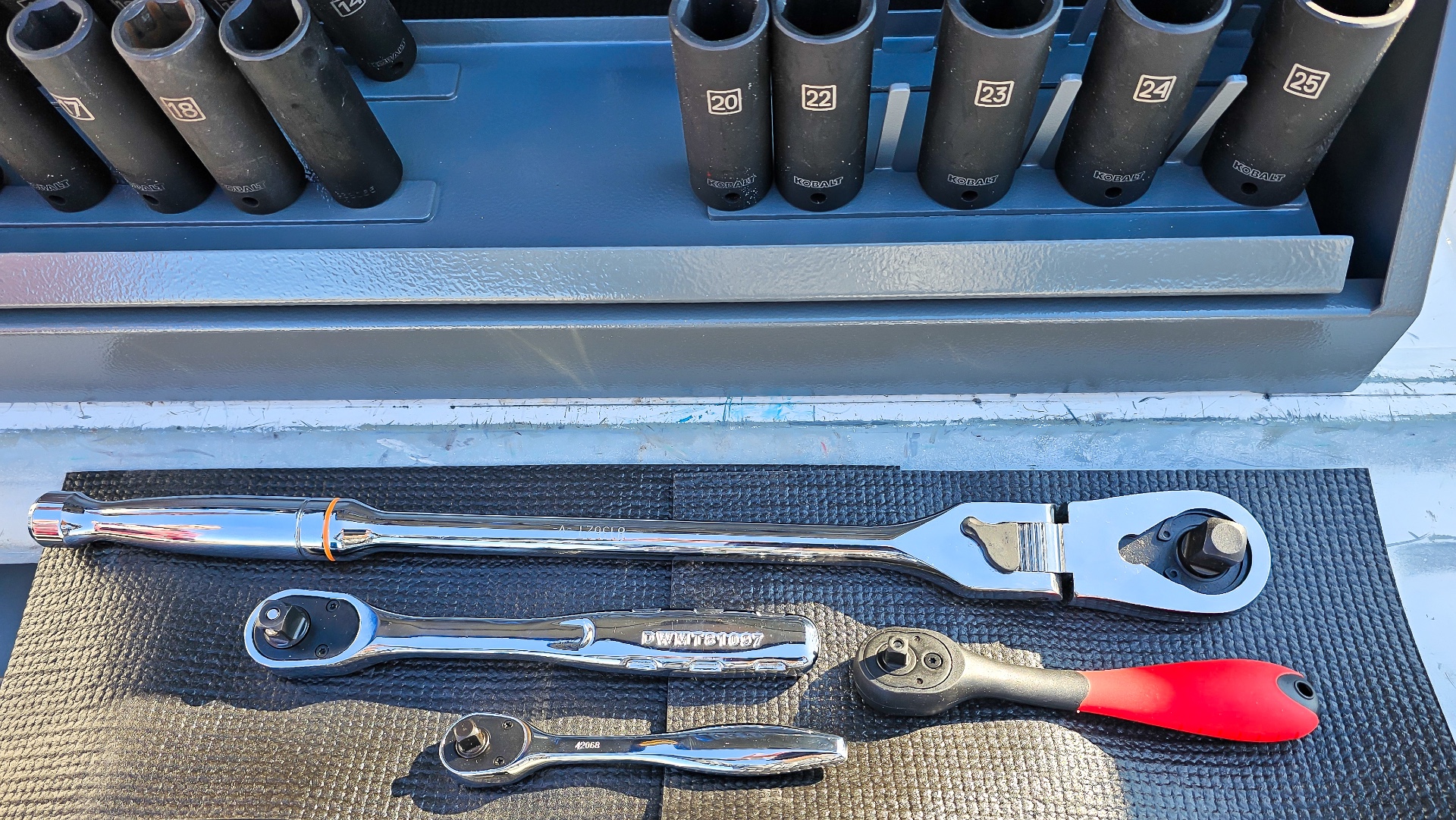
Ratchets Comparison Chart
| Drive Size | Tooth Count | Material | Price | |
| DeWalt Quick Release | ⅜-inch | 72 | Chrome vanadium | $29.99 |
| Ares Reversible | ¼-inch | 120 | Chrome vanadium | $14.92 |
| Tekton Quick Release | ¼-inch | 72 | Alloy steel | $15.00 |
| Gearwrench Flex Head | 1/2-inch | 90 | Alloy steel | $61.00 |
| Makita Cordless | ⅜-, ¼-inch | NA | Multi-material | $266.65 |
| Neiko Reversible | ⅜-inch | 72 | Chrome vanadium | $19.97 |
| ACDelco Power | ⅜-inch | NA | Alloy steel, rubber | $63.99 |
| Ares Ratchet Set | ¼-, ⅜-, ½-inch | 90 | Chrome vanadium | $48.12 |
Our Top Picks
Whether you’re looking to save a few bucks, invest in a premium tool, or need just a little more torque, there’s a ratchet for you. Find out how our tested ratchets fared below and, if one of those is not what you’re looking for, check out the untested ones we selected based on their ratings and reputation.
Best Overall
DeWalt ⅜-Inch Quick-Release Ratchet
What We Like
- High-quality chrome vanadium steel
- 5-degree swing is ideal for tight spaces
- Quick-release button for socket changes
- Smooth ratcheting action
What We Don’t Like
- Only compatible with ⅜-inch sockets
Specs
- Drive size ⅜ inch
- Total count 72
- Material Chrome vanadium
Our Ratings: Performance 4.75/5; Comfort 5/5; Durability 5/5; Value 4.75/5
DeWalt is best known for its battery-powered tools, but the company also makes quality hand tools—and this ⅜-inch ratchet excelled in our hands-on tests. It features a quality chrome vanadium steel body that is sturdy and contoured, making it easy to grasp. 72-tooth-count gearing allows this ratchet to progress after only 5 degrees of swing. And, to help keep knuckle-busting to a minimum, we appreciated its smooth quick-release button on the rear of the head to simplify socket swaps.
We found the directional lever easy to switch with just enough resistance to keep it in place. We fitted the ratchet with a variety of ⅜-inch sockets and used it to tighten and loosen dozens of fasteners. The ratcheting mechanism was smooth and efficient, allowing us to handle the fasteners quickly without having to reposition the tool.
What our tester says: “This is an excellent all-purpose quick-release ratchet that easily handled every fastening task I threw at it, and it earned a permanent spot in my home tool kit.”—Glenda Taylor, Product Reviews tester and writer
Get the DeWalt ratchet on Amazon or Blain’s Farm & Fleet.
Best Bang for the Buck
Ares ¼-inch Reversible Ratchet
What We Like
- High quality at a budget-friendly price
- Made from strong chrome vanadium steel
- High (120) tooth count and 3-degree arc
- Easy pull/push socket changes
What We Don’t Like
- Thinner ratchet limited to light-duty use
Specs
- Drive size ⅜ inch
- Tooth count 120
- Material Chrome vanadium
Our Ratings: Performance 4.5/5; Comfort 4.5/5; Durability 4.25/5; Value 4.75/5
You can enjoy the benefits of a ratchet without spending a lot, and we found a great deal on a high-quality Ares model. The Ares 42068 features a 1/4-inch drive and a 3-degree swing arc, so we were able to tighten and loosen fasteners in spots with very limited space.
It’s designed with chrome vanadium steel to be strong, durable, and easy to clean, but it doesn’t have a quick-release button. Still, we had no problem removing sockets and putting new ones on. Just a firm pull on the socket was all we needed to remove it from the drive.
Aside from its affordable price tag, the real benefit of this ratchet is its gearing. This model has 120 teeth, requiring just 3 degrees of swing. That helped us with fasteners in even the tightest situations.
The Ares ratchet best suits small fasteners found in electronics, appliances, and bicycle maintenance. In fact, we added it to our take-along bike bag, since there’s no telling when we’ll need to make adjustments or tighten bolts on the road.
Get the Ares ¼-inch ratchet on Amazon or Ares Tool.
Best Ergonomic
Tekton ¼-Inch Composite Quick-Release Ratchet
What We Like
- Comfortable non-slip grip
- Ideal for light-duty projects
- Slightly offset handle for maneuverability
- Quick-release socket button
What We Don’t Like
- Shorter handle limits torque
Specs
- Drive size ¼ inch
- Tooth count 72
- Material Composite shell and chrome vanadium core
Our Ratings: Performance 4.5/5; Comfort 5/5; Durability 4.5/5; Value 4.75/5
Those looking for a ratchet that’s easy and comfortable to grip should consider Tekton’s ¼-inch ratchet. It has an ergonomic, non-slip grip that was easier on our hands than the bare steel models. We found it especially handy for tinkering with small, light-duty projects like audio/video, computer, and small engine work.
This Tekton ratchet features 72 teeth and a compact head that fits in tight spots and requires just 5 degrees to progress. It also has a slightly offset handle that curves and provides more room for hands and fingers, which was a real knuckle saver in tight spots during our testing.
The body consists of a composite shell with a chrome vanadium core, making it fairly strong yet lightweight. We appreciated the quick-release button, which made swapping tiny, tough-to-grab sockets easier. However, due to the shorter-length handle, we weren’t able to apply a lot of torque, so this shouldn’t be the only ratchet in a tool kit.
Get the Tekton ratchet on Amazon or at The Home Depot.
Best Flex Head
Gearwrench ½-inch Flex Head Locking Ratchet
What We Like
- 4-degree arc swing for tight spots
- Locking flex head
- Long, 17-inch handle for high torque
What We Don’t Like
- Not for small fastener tasks
Specs
- Drive Size ½ inch
- Tooth Count 90
- Material Alloy steel
Our Ratings: Performance 4.75/5; Comfort 4.75/5; Durability 5/5; Value 4.5/5
Accessing hard-to-reach bolts just got simpler with Gearwrench’s flexible head ratchet. We tested the ½-inch drive model that has a 17-inch handle. This larger ratchet is a good pick for tightening and loosening lug nuts on wheels, and we appreciated being able to tilt the locking flex head to reach in tight spots that would otherwise have been challenging to access.
At 2.53 pounds, this flexible ratchet is substantial enough to allow us to apply high torque to remove stuck-on bolts. The ratcheting action is smooth, and the tool offers a 4-degree arc, which makes it worthwhile in spots where movement is restricted.
The handle is semi-ergonomic, but one downside is the ribbing on its surface, which was uncomfortable when we really grasped it tightly. It could have been a little smoother to prevent it from digging into our palms. Still, this is a powerful tool, and with a pair of work gloves, you’ll never feel the ribbing.
Get the Gearwrench ratchet at The Home Depot or Fastenal.
Best Electric
Makita 18V LXT Lithium-Ion Cordless Ratchet Kit
What We Like
- Interchangeable ¼- and ⅜-inch anvils
- Electric brake for safety
- Kit includes tool, battery, and charger
What We Don’t Like
- Awkward directional switch design
Specs
- Drive size ⅜ and ¼ inch
- Tooth count Not specified
- Material Not specified
We compared the Milwaukee cordless ratchet in a different hands-on test against other power ratchets and it took top honors in that lineup, so we wanted to include it here as well. It comes with two anvils (⅜ inch and ¼ inch bases) that pop in and out of the ratchet head to hold different sizes of sockets, so we could swap between the two sizes when testing various drive sockets. Along with the anvils, it comes with the ratchet tool, the charger, and a 2Ah battery. This electric ratchet also features a brake and an onboard LED light for illuminating engine bays and other dark spaces.
We liked that it had a lower-profile head than some of the other large ratchets, so it could sneak into spots the others couldn’t. However, we thought the directional switch was a little wonky. It’s a tiny lever that could potentially catch on wires or hoses.
What our tester says: “This Makita battery ratchet proved to be my favorite tool during testing. It was more or less on par with the others in terms of power, but its speed really set it apart.” —Tom Scalisi, Product Reviews tester and writer
Get the Makita cordless ratchet at Amazon or The Home Depot.
More Great Options
We didn’t test the following ratchets, but they made our shortlist based on quality, reported performance, and consumer reviews. If you haven’t found a ratchet that fits your individual needs yet, check these out.
Best Handle
Neiko ⅜-Inch Drive Extendable Ratchet
What We Like
- Telescoping handles adjusts for length
- Rubber grip provides a secure grasp
- 5-degree arc swing
What We Don’t Like
- Heavier than other models
Specs
- Drive size ⅜ inch
- Tooth count 72
- Material Chrome vanadium and rubber
Home mechanics who want a bit more comfort and flexibility from their ratchet should consider this ⅜-inch extendable ratchet from Neiko. We like that it’s made from high-quality chrome vanadium and features a sure-grip rubber handle that telescopes for different fastening projects. Simply pull back on the handle’s collar and extend it to the desired length; when released, the locking collar will maintain the length of the handle. It adjusts from 8½ to 12⅜ inches.
The handle’s rubber grip promotes comfort and offers a good grasp in wet or greasy conditions. Also, this model’s 72-tooth gear requires smaller ratchet increments (just 5 degrees)—something that can be important with the handle extended to reduce unnecessary movement. However, we think the weight of this ratchet might lead to hand fatigue with repeated use. While this Neiko is capable in nearly any scenario, DIYers might want to own a lighter model for long ratcheting jobs as well.
Get the Neiko ratchet on Amazon.
Best Rechargeable
ACDelco Power 12V ⅜-Inch Cordless Ratchet
What We Like
- 12-volt battery operated ratchet
- Provides up to 100 pounds of torque
- Low-profile design for tight spots
What We Don’t Like
- Not suited to heavy-duty work
Specs
- Drive size ⅜ inch
- Tooth count Not specified
- Material Alloy steel, rubber
For DIYers who don’t mind spending a little extra cash for added convenience, we suggest the ACDelco Power 12V ⅜-inch cordless ratchet. This tool all but eliminates scraped knuckles and unnecessary movements. It uses a 12-volt battery to power the ratcheting function, allowing users to work faster and more efficiently.
This cordless ratchet is handy for tightening bolts in narrow locations. We really like its low-profile design, which isn’t much larger than a typical ratchet. It’s also useful for dealing with multiple fasteners over the course of a project, and it comes with seven sockets and a ¼-inch drive adapter.
Alone, the ACDelco provides 45 pounds of torque, which is more than enough to snug a bolt initially. Users can then apply up to 100 pounds of torque by hand to tighten the bolt all the way. But since 100 pounds is its maximum torque output—which is plenty for lawn mowers, bikes, and regular shop use—it won’t cut the mustard for heavy-duty work on trucks, trailers, or professional applications.
Get the ACDelco ratchet on Amazon or at Walmart.
Best Heavy-Duty
Ares ½-Inch Drive Ratchet
What We Like
- Heavy-duty construction
- Quick-release button
- Available in a 3-piece ratcheting wrenches set
What We Don’t Like
- Smooth handle doesn’t offer much grip
Specs
- Drive Size ½ inch
- Tooth count 90
- Material Chrome vanadium
When it comes to stubborn bolts and heavy-duty work, we think the Ares ½-inch drive ratchet could be the go-to tool for getting the job done. This ratchet accepts ½-inch sockets and is built to withstand plenty of torque.
The Ares ratchet features a chrome vanadium body and long handle, making it strong and helpful for applying torque. Yet, this model also retains some of the convenience of smaller models, thanks to features like its 90-tooth count that requires only 4 degrees of rotation and a quick-release button that makes it easier to remove heavy-duty sockets. The smooth grip, however, may become an issue if users exert a lot of pressure: the absence of texture could cause a hand to slip, so we suggest wearing non-slip gloves when using this ratchet in high-torque situations.
Get the Ares ½-inch ratchet on Amazon or Ares Tool.
Jump to Our Top Picks
How We Chose and Tested the Best Ratchets
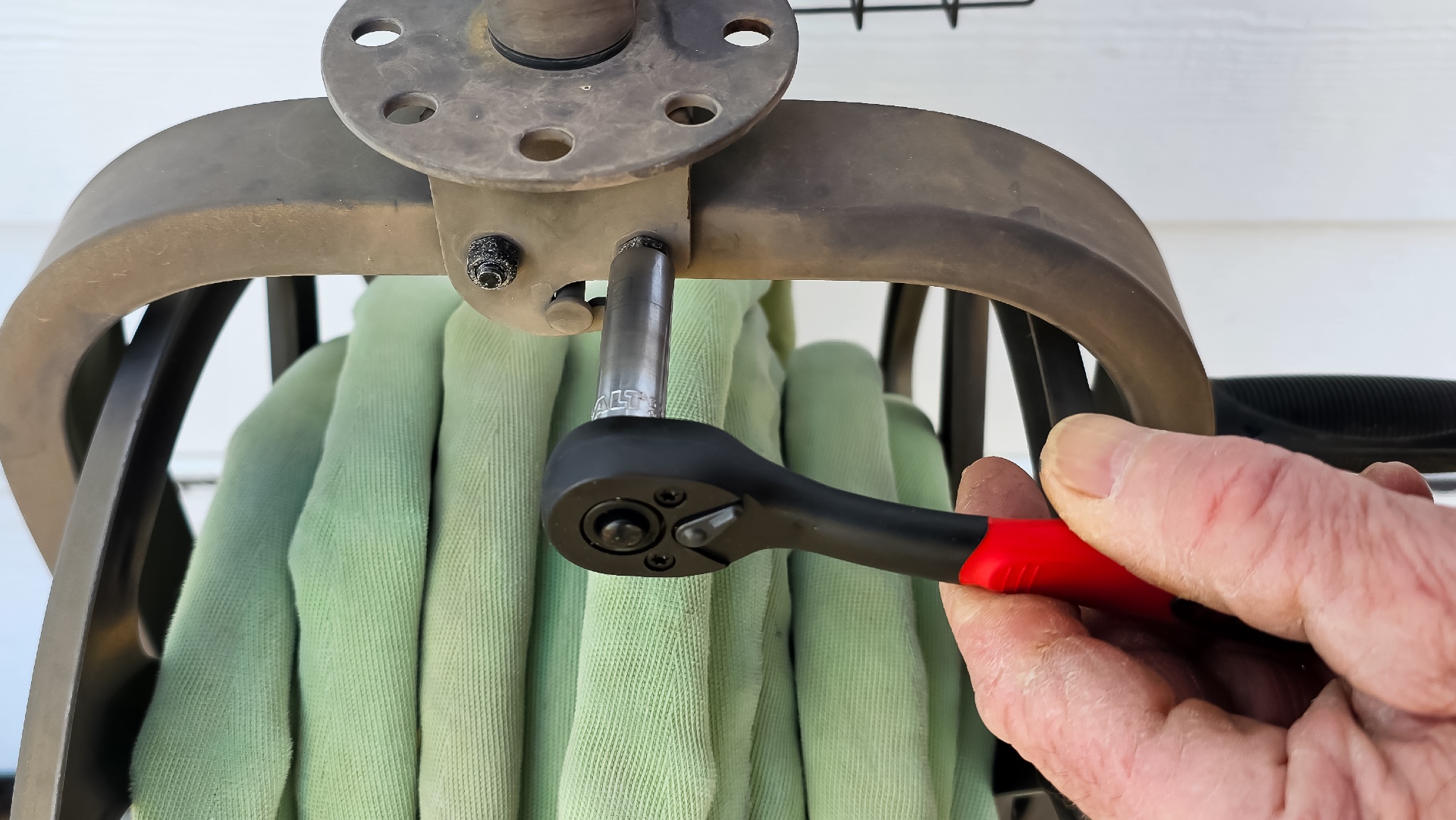
In compiling this guide, we performed extensive product research to collect some of the best ratchets on the market for comparison. We compared their prices, features, and fabrication materials to ensure they had what it took to make the list.
While we considered over 30 highly-rated ratchets, we eventually narrowed our choices down to what we felt were the best eight, and then we selected the top five for hands-on testing. We set up a testing area in our workshop where we inserted various-sized nuts through holes we drilled in boards and fitted them with corresponding bolts. We secured the bolts as tightly as possible with the ratchets and then loosened them, noting how easy and effective each model performed.
We also tested the ratchets in real-world situations by loosening and tightening fasteners on our cars and motorcycles. We sought out bolts in tight spots and even found some frozen bolts to see if we could break them loose using the correct sockets. We awarded points based on a rubric—the better a ratchet performed on a test or assessment, the higher the points. After testing, we averaged the points to find the best overall ratchet and to categorize the others according to their ideal uses.
| Products tested | 5 |
| Time spent testing | 3 days |
| Tests performed | 4 |
| Price range | $15 to $300 |
| Performance | Comfort | Durability | Value | |
|---|---|---|---|---|
| DeWalt Quick Release | 4.75 | 5 | 5 | 4.75 |
| Ares Reversible | 4.5 | 4.5 | 4.25 | 4.75 |
| Tekton Quick Release | 4.5 | 5 | 4.5 | 4.75 |
| Gearwrench Flex Head | 4.75 | 4.75 | 5 | 4.5 |
What to Consider When Choosing the Best Ratchet
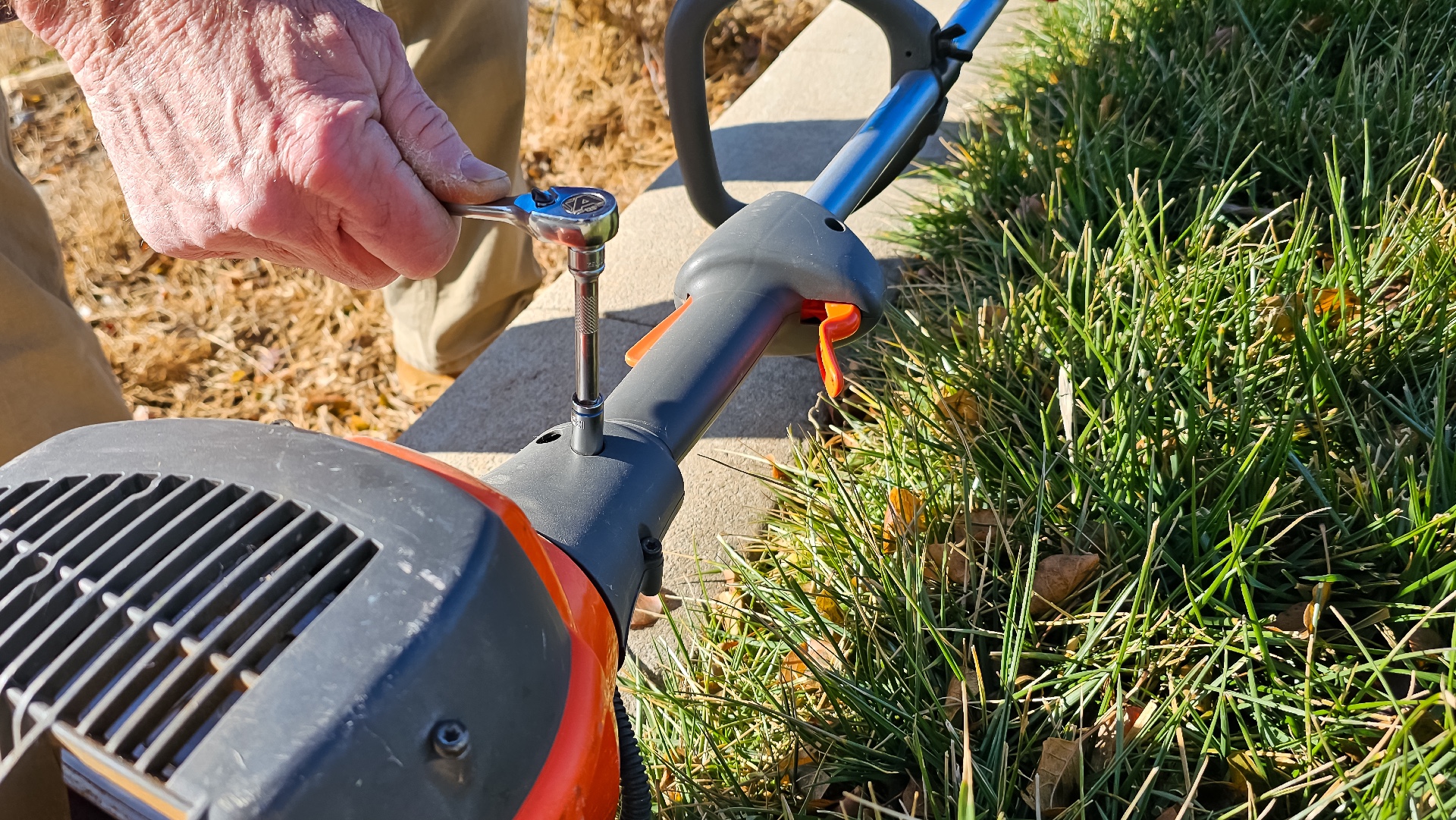
While most ratchets follow a very similar exterior design, things do differ internally between them. If shoppers consider features such as size, material, and convenience, they’ll soon see that not all ratchets are built to the same standards.
A ratchet has a rotating gear inside its gear head and two levers (known as pawls) that catch the gear’s teeth. One pawl, when engaged, tightens the nut or bolt, while the other pawl is used to loosen a fastener as the user turns the handle. A ratcheting wrench is not the same as a torque wrench, although torque wrenches often have a ratcheting movement.
Drive Size vs. Socket Size
Shoppers need to understand two measurements when it comes to ratchets: drive size and socket size. Drive size refers to the size of the sockets that fit on the ratchet’s drive square (the square head that sockets snap onto). Socket size simply refers to the size of the nut or bolt that a particular socket was intended for, describing the open end of the socket.
The three common drive sizes that most DIYers will become familiar with over time are ¼ inch, ⅜ inch, and ½ inch (those larger than ½ inch are more common for boilermakers and pipefitters than DIYers). The smaller the drive size, the lighter the duty that the ratchet was intended for.
If a shopper is going to buy just one of these tools, they should consider a ⅜-inch drive ratchet with compatible sockets. These ratchets are small enough to fit in tight places, like alongside an engine block or the underside of a dishwasher, but robust enough to withstand quite a bit of force.
Tooth Count
Tooth count refers to the number of notches in the ratcheting gear inside the ratchet’s head—a number that makes a big difference depending on use. A ratchet with a high tooth count (72 teeth and up) means that less handle movement is required for progress, while a lower tooth count (as few as 32 teeth) requires a lot more room to manipulate the ratchet handle and turn the fastener. This is often expressed in degrees, indicating how far a handle must rotate in order for the pawl to pick up the next tooth and continue making progress:
- 90 teeth: 4 degrees
- 72 teeth: 5 degrees
- 60 teeth: 6 degrees
- 32 teeth: 11+ degrees
Users will appreciate a high tooth count in tight scenarios where their range of motion is limited, like inside a car’s wheel well during a brake job. The ratchet can be twisted in smaller increments to make progress on the fastener, whether tightening or loosening.
Socket Release
Most ratchets on the market today include a quick-release button on the backside of the ratchet head. This button releases the socket from the face of the tool, making for a convenient way to swap sockets for differently-sized fasteners without pulling the socket off by hand.
Without this feature, a user will have to pull the socket off with their free hand—and in tight quarters, like while working under a car, they run the risk of smashing a hand into something when the socket pops loose. What’s more, greasy hands simply make socket removal for snap on ratchets frustrating. Even sockets with nonslip textures can be challenging to remove with just a little oil on their surface.
Quick-release ratchets are safer and easier to use. It’s a good idea to oil them regularly to keep them working smoothly.
Length and Weight
The longer the ratchet handle, the easier it will be to apply torque to a fastener. While a longer handle will require less effort to release a bolt, it also makes overtightening the fastener possible, potentially stripping or tearing the head off. Most ratchet handles are designed for optimum torque application—meaning they’re long enough to apply leverage and loosen a bolt but not so long that the fastener is destroyed with marginal effort
Another consideration related to length is whether the user will be able to manipulate the ratchet in a given position. A long-handled ratchet can be near useless under the hood of a car, while a thinner ratchet with a short handle can fit almost anywhere.
In terms of weight, heavier ratchets will obviously fatigue the user faster. Keep in mind that when working overhead, such as when driving lag screws through a deck’s ledger board, even a lightweight ratchet can feel heavy and cumbersome. It’s generally best to purchase a high quality, lightweight model that can get the job done without tiring the user out.
Material
Almost all ratchets on the market today are built from chrome vanadium steel, but quality varies. Chrome vanadium is an alloy—a combination of metals designed to deliver particular attributes, such as shock resistance, strength, weight, and other characteristics, as well as cost savings.
As these alloys are essentially the result of a metallurgic recipe, they vary in quality depending on the amounts of materials combined. This is why users are far more likely to get the best combination of strength, durability, and weight if they purchase a high-quality ratchet from a trusted brand.
FAQs
You’ve learned about the different types and styles of ratchets, as well as some excellent choices, but you might still have some questions on usage and size. Most of these questions apply to all models, but you can also contact the manufacturer with any questions that aren’t covered here.of these heavy-duty models can exert, it may be necessary to choose a set of impact-ready sockets.
Ratchets have a rotating gear inside their heads and two levers (known as pawls) that catch the gear’s teeth. One pawl engages, determining which direction the gear can spin freely.
Your best bet is to pick up a ⅜-drive model. They’re small enough for tight clearances but robust enough to handle some torque and pressure.
Quality ratchets generally have 72 teeth or more. However, ratchets designed for truly heavy-duty hardware, such as those on heavy construction equipment, may have fewer teeth in order to make each individual tooth more robust. In fact, some double-pawl ratchets are able to click 80 or more times despite having just 40 or so teeth. To apply the amount of torque some of these heavy-duty models can exert, it may be necessary to choose a set of impact-ready sockets.
Yes, they can wear down over time, especially with heavy or frequent use. The higher the quality, the longer they last.
It’s a good idea to lubricate the ratcheting mechanism periodically with light machine oil or lithium grease to keep it moving smoothly.
No. Ratchets are typically sized to fit one of the three most common socket sizes (¼, ⅜, and ½ inch), although you can find ratchet sets with all three sizes and a few ratchets come with removable anvils to suit two or more socket sizes.
Meet the Testers
Glenda Taylor is a contractor, product tester, and writer focusing primarily on construction, DIY tools, and home appliances.
Tom Scalisi is a full-time DIY and construction writer for many of the largest websites in the industry, including BobVila.com, This Old House, Family Handyman, and Forbes.




